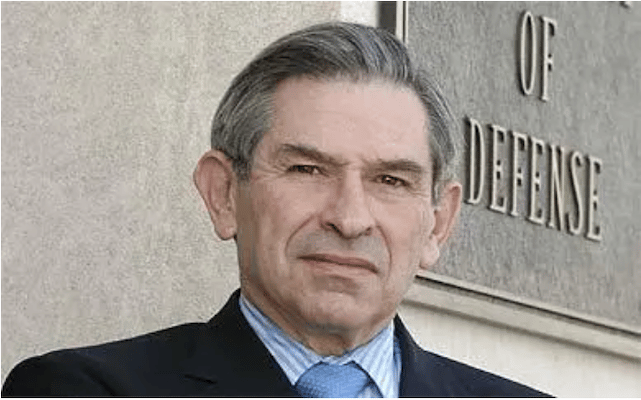The Project for a New American Racist Century is omnipresent in the capitals of Europe today. From Dublin to Berlin—Ukrainian colors are on flagpoles, bus stops and buildings. The subtext is blonde hair and blue eyes.
America and its European clients (the North Atlantic Treaty Organization—NATO) now see Ukraine much like Israel sees the West Bank—a frontier beyond which are subhuman Asians.
While Israel has built an apartheid wall—708 kilometers long and up to 8 meters high—that separates itself from Palestinians, NATO has just built an apartheid regime that separates itself from Russians.
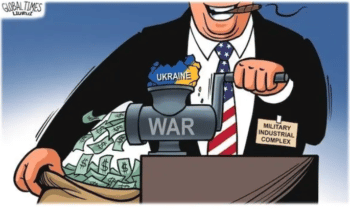
[Source: mronline.com]
The liberal capitalist mask has suddenly been replaced by a Ukrainian flag. Ethnicity and extreme nationalism—the Nazi kind—have been weaponized in Europe again. And NATO did it. Why?
What is remarkable about today’s Russophobia is its rapid totality. Overnight—a switch has been turned on and everything is yellow and blue. However, this is not the result of righteous Western indignation—concerning Russia’s military operation in Ukraine—but is the result of U.S. imperial strategy. It is a long thought-out master plan. To be precise, it stems from the Wolfowitz Doctrine.
A Time of Wolves
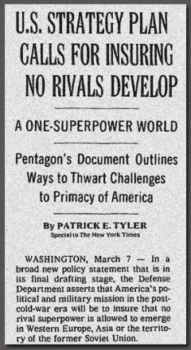
[Source: nsarchive2.gwu.edu]
The doctrine declares that the United States must never tolerate the emergence of another great power. It is a U.S. commitment to destroy or “prevent any hostile power from dominating a region whose resources would, under consolidated control, be sufficient to generate global power.”
Paul Wolfowitz was the Pentagon’s Under Secretary for Policy in 1992. That year’s “Defense Planning Guidance for the 1994-99 fiscal years”—written by Wolfowitz and his aides (I. Lewis “Scooter” Libby and Zalmay Khalilzad) and overseen by Wolfowitz’s bosses (Dick Cheney and Colin Powell)—was, according to The New York Times, a “U.S. Strategy Plan For Insuring No Rivals Develop.”1
After 1992, Wolfowitz & Co. re-appeared as the backbone of George W Bush’s presidency (2001-09). And as such, they shaped the Bush Doctrine that reiterated the Wolfowitz Doctrine: U.S. unilateralism—the right of the U.S. to act preemptively throughout the world—in defense of its interests.
The Power of the Pentagon
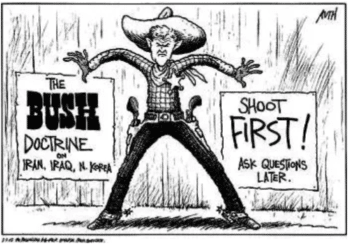
[Source: random-blather.com]
After the Cold War the Pentagon’s budget increased beyond measure. In 1991 it was about $300 billion, while in 2021 it was around $700 billion. In contrast Russia’s military budget for 2021 was roughly $70 billion and China’s $290 billion.2
As a result of this unprecedented investment in war, U.S. military bases spread like a contagion around the world. By 2021, there were at least 800 U.S. bases outside U.S. borders.3
In 1991 U.S. soldiers were positioned in 40 countries. In 2021, U.S. soldiers were in 80. In comparison, Russia—in 2021—had military bases in six, or maybe eight, countries and China in one, maybe two or three.4
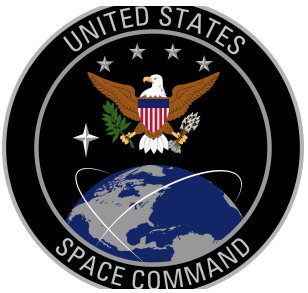
[Source: wikipedia.org]
To manage this “Empire of Bases” the Pentagon has divided the world into six command structures—Northern Command (North America), Southern Command (South America), Central Command (the Middle East and Central Asia), Africa Command, Indo-Pacific Command and European Command.
The Pentagon even has a command structure that manages the Earth’s atmosphere: Space Command. This totalitarian system is meant to fulfill America’s imperialist dream: “full spectrum dominance.”
In brief then, U.S. foreign policy in the 21st century is intentionally authoritarian and warlike because it is defending U.S. unilateralism. And the dogma or the rigid logic upon which it rests is the Wolfowitz Doctrine.
America’s “forever wars” since 2000 prove the point. By targeting geopolitical hotspots, sources of energy and ethnic fault lines, the U.S. has—overtly and covertly—been waging war against the world. Afghanistan, Iraq, Libya, Syria, Yemen and now Ukraine are the obvious victims of this strategy to unnerve and control the planet.
Russia Says No
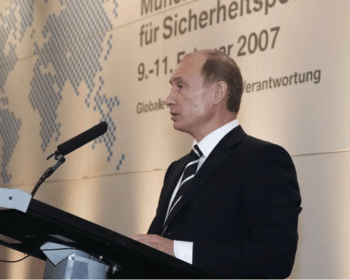
Vladimir Putin speaking at 2007 Munich Security Conference. [Source: blogs.prio.org]
What is a unipolar world? ….it refers to one type of situation, namely one center of authority, one center of force, one center of decision making. It is a world in which there is one master, one sovereign….this is pernicious…I consider that the unipolar model is not only unacceptable but also impossible in today’s world…5
Russia’s underlying concern was the advance of U.S. military bases up to its borders. Operating under the cover of NATO, it was clear, even before 2007, that America’s Empire of Bases was expanding provocatively in Eastern Europe. Far from the North Atlantic, “NATO” was moving East toward the oil and gas fields around the Black and Caspian Seas. In other words, the unipolar USA was aggressively penetrating Russia’s borderlands.
And the Russian President made this clear in his 2007 speech:
[After Moscow disengaged from Eastern Europe]…it turns out that NATO has put its frontline forces on our borders…I think it is obvious that NATO expansion…represents a serious provocation…Against whom is this expansion intended?…[The USA is] trying to impose new dividing lines and walls on [Europe]…6
Russia Refutes the Wolfowitz Doctrine in Georgia and Syria—and America Retaliates in Ukraine
Russia’s brave words directed at the American Empire began to materialize immediately. In April 2008, in Bucharest, “NATO leaders promised Ukraine and Georgia [that] they would one day join the Western defense alliance.” And four months later (August 7), after being integrated into America’s “foreign legion” in Afghanistan and Iraq, Georgia attacked the breakaway region of South Ossetia near Tbilisi, which was then being protected by Russia.
In response Russia waged a five day war against Georgia. It was a turning point in post Cold War geopolitics. Another power—Russia—was unafraid to militarily challenge a U.S. / NATO proxy. America’s expanding unipolar network was experiencing pushback.
Four years later in Syria, in the wake of the 2010 / 11 uprisings in Tunisia and Egypt, America’s Central Intelligence Agency (CIA) began a multi billion dollar covert action in Syria called “Timber Sycamore” (2012—2017).
The U.S. had been targeting the Syrian government for decades. But this targeting became pronounced after Syria criticized the 2003 U.S. invasion of Iraq.
Indeed, Richard Perle and Douglas Feith—among the neoconservative architects of the U.S. invasion of Iraq—had already, in 1996, called for a direct confrontation with Syria.7
Syria’s unfortunate place in America’s plans, moreover, was clarified to U.S. General Wesley Clark in 2003—when a Pentagon official gave him a list of “seven Muslim states” which America was planning to attack (Syria, Iraq, Lebanon, Iran, Sudan, Libya and Somalia).8
“Timber Sycamore” was the realization of the Syrian part of this overarching idea to conquer, once and for all, oil rich Western Asia. However, there was one obstacle: Russia.
In the summer of 2013—just when the U.S. was ready to bomb Syria outright—because of the alleged chemical attack in Ghouta—Russia intervened diplomatically. And successfully derailed America’s unipolar right to wage war.

Victoria Nuland—Wolfowitz no doubt sees in her a kindred spirit. [Source: defensenews.com]
In the words of journalist Robert Parry:
[Russia] had made [itself] a major annoyance in Neocon World….….[Russia had] brokered a deal in which Assad agreed to surrender Syria’s chemical weapons arsenal….The arrangement was a huge letdown for the neocons and Israeli officials who had been drooling over the prospect that a U.S. bombing campaign would bring Assad to his knees and deliver a strategic blow against Iran, Israel’s current chief enemy….
…So, the troublesome [Russia] had to be put in play. And, [the National Endowment for Democracy’s Carl] Gershman was quick to note a key Russian vulnerability, neighboring Ukraine, where a democratically elected…president, Viktor Yanukovych, was struggling…9
America Says Russia Must Go

Carl Gershman—neo-con Russia hawk. [Source: ned.org]
In 2015 the Russian president, Vladimir Putin, reiterated his 2007 message:
I cannot help asking those who have force that situation [the U.S. imperialists]: Do you realize what you have done?…The fact [is that Russia] can no longer tolerate the current state of affairs in the world.10
The United States responded to this historic insubordination by recalibrating its foreign policy. It responded by updating the Wolfowitz Doctrine.
In 2017 America released its new National Security Strategy and in 2018 the Pentagon released its National Defense Strategy—the latter being the Pentagon’s interpretation of the former. The message was succinct and profound:
Inter-state strategic competition, not terrorism, is now the primary concern in U.S. national security.11
9/11 and those responsible for it were officially forgotten. Now (2018 and after) the countries which did not act in accordance with U.S. preeminence were to be the principal targets of U.S. power—in particular, Russia.
Alongside China, Russia was labeled a “revisionist” state because it—in America’s eyes—”undermined” the “international order” and the “rules of the road”; Russia had become a “long term strategic…[priority]” for the Pentagon.12
In other words: From 2018 onwards, Russia was America’s official enemy. The Pentagon’s job therefore was to “deter or defeat” Russia. According to the Pentagon’s National Defense Strategy:
With our allies and partners [NATO/EU], we will challenge [Russia] by maneuvering [it] into unfavorable positions, frustrating [its] efforts, precluding [its] options while expanding our own, and forcing [it] to confront conflict under adverse conditions.13
This was a de facto declaration of war. And it did not just involve America’s Empire of Bases. According to the Pentagon itself, it meant that the totality of American power was—from 2018 onwards—targeting Russia. This included: the “Departments of State, Treasury, Justice, Energy, Homeland Security, Commerce, USAID, as well as the Intelligence Community, law enforcement, and others….”14 It involved: “diplomacy, information, economics, finance, intelligence, law enforcement, and military.”15
The Wolfowitz Doctrine Gets the RAND Treatment
America’s general targeting of Russia became more specific and detailed in a study released by the RAND Corporation in 2019—the RAND Corporation being the prestigious California-based, and Pentagon-linked, research center.
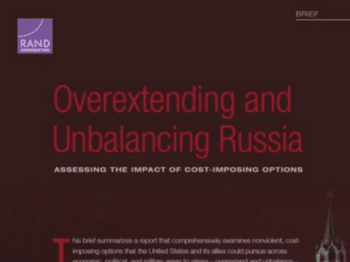
[Source: sana.sy]
The objective of the study was to identify Russia’s vulnerabilities and anxieties—and to suggest ways to exploit them. It speaks of “geopolitical measures to bait Russia”; sanctioning Russia’s “comparatively small” economy; blocking the export of Russia’s energy; increasing the power of NATO in Europe; and increasing lethal aid to Ukraine.16
The study is a 500-page plan to corner Russia so as to fatally weaken it. And it is a plan which the current U.S. Defense Secretary, Lloyd Austin, seems to have completely absorbed. His words, in April of this year, echo the RAND study:
We want to see Russia weakened.17
Indeed the RAND study began an official U.S. process that has ended up in thoughts of Russia’s complete destruction. In June of this year (2022), the Commission on Security and Cooperation in Europe (the U.S. Helsinki Commission)—argued publicly that it is a “moral and strategic imperative” to balkanize or break up Russia.18
It’s the Global Economy Stupid—the George F. Kennan Doctrine
The Wolfowitz Doctrine is unoriginal. Paul Wolfowitz is not the strategist extraordinaire who has shaped the last three decades of Empire. He was only perpetuating the banal logic of U.S. imperialism—the logic of corporate America that emerged out of World War II.
The purpose of this mundane imperialism is to maintain economic inequality on a global scale. The godfather of the U.S.’s Cold War foreign policy, George F. Kennan, explained it clearly in a top secret 1948 document.
Furthermore, we have about 50% of the world’s wealth but only 6.3% of its population. This disparity is particularly great as between ourselves and the peoples of Asia. In this situation, we cannot fail to be the object of envy and resentment. Our real task in the coming period is to devise a pattern of relationships which will permit us to maintain this position of disparity without positive detriment to our national security. To do so, we will have to dispense with all sentimentality and day-dreaming; and our attention will have to be concentrated everywhere on our immediate national objectives. We need not deceive ourselves that we can afford today the luxury of altruism and world-benefaction.19

George F. Kennan [Source: britannica.com]
The key problem for the American Empire today is that “the peoples of Asia” are currently ending the fundamental disparity which Kennan highlighted in 1948. According to the Financial Times:
Asia is already home to more than half the world’s population. Of the world’s 30 largest cities, 21 are in Asia, according to UN data. By next year, Asia will also become home to half of the world’s middle class, defined as those living in households with daily per capita incomes of between $10 and $100 at 2005 purchasing power parity (PPP). Since 2007, Asians have been buying more cars and trucks than people in any other region—by about 2030 they will be buying as many vehicles as the rest of the world combined…
To put this in perspective, Asia accounted for just over one-third of world output in 2000.20
Russia per se is not an existential threat to the American Empire but the economy of Asia is. And Russia is a key part of this Asian economy.
In 2001 Russia became a founding member of the Shanghai Cooperation Organization (SCO) which links the political economies of Russia, China and Central Asia.
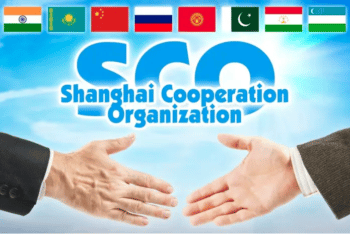
[Source: defense.info]
Russia is the natural bridge linking the Belt and Road Initiative to Berlin—Europe’s most dynamic economy. Or Russia was the bridge linking East and West before U.S. President Joe Biden destroyed it this year.
When the U.S. President unilaterally told the German Chancellor (Olaf Scholz)—last February 7—that the new gas pipeline linking Russia and Germany (Nord Stream 2) was a nonstarter “if Russia intervened” in eastern Ukraine—an intervention the U.S. was enthusiastically provoking—the U.S. was sabotaging the economics of Eurasia and the further boost this would have given to Asian power.
This overt sabotage was necessary from the U.S. imperialist point of view because logic suggests that, if China, Russia and Germany link up with game-changing pipelines and infrastructural projects (if Asia economically unites with Europe), America will eventually become a backwater.
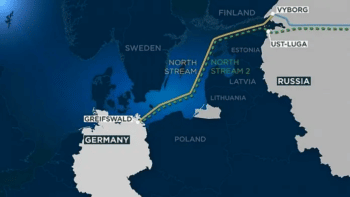
The Nord Stream 2 pipeline would be a key link between East and West that could make the U.S. marginal and irrelevant. [Source: euronews.com]
The Wolfowitz Doctrine Means Permanent Race War
As the Financial Times indicates above, the Asian Century has already begun. And apart from war, America cannot do anything about it. So war it is. But when has it been otherwise?
As George Kennan intimated: When dealing with Asia, the U.S. must prioritize its interests and nothing else. America must be immoral/inhumane to say the least. Since 1948 U.S. planners have been following his advice. America’s forever wars in Asia are a testament to this—Korea, Vietnam, Afghanistan, Palestine, Iraq, Syria, Yemen and now Russia.
To rationalize this 70-year-old war of aggression, America has only one card to play: racism. A clash of values is the official cover for America’s permanent hostility toward Asia.
This is combined with the false claim that America is democratic and China authoritarian, implying that the U.S. needs to try and export democracy to prevent countries from falling into China’s authoritarian orbit.

[Source: washingtontimes.com]
Today this American contempt for Russia is supercharged, so much so that Russophobia now is the continuation of Orientalism—that racist super ideology that powered Western imperialism for centuries. As Edward Said wrote:
“The general basis of Orientalist thought is an imaginative geography dividing the world into two unequal parts, the larger and ‘different’ one called the Orient, the other, also known as our world, called the Occident or the West.”21
The Wolfowitz Doctrine would have it no other way. It is structurally incapable of opening up rationally to the successful independence or successful development of any people on Earth. If it did, it would signify the suicide of U.S. imperialism.
The Wolfowitz Doctrine has locked the U.S. into a zero-sum world: Any criticism of America is an existential threat to America; it is either another American century or the end of America.
In this Manichaean mindset there is no compromise with the other. If the other does not submit to America, a war of extermination against the other is triggered.
In this Weltanschauung there is no equality, only hierarchies. In this world of winners and losers, the losers—their race and culture—are dismissed as second or third class.
In this sense America or the Occident is behaving like Israel, America’s dystopian ally in West Asia. In other words, America is trapped in an endless confrontation with the Orient—a confrontation of its own making. Like a settler colony infused with racism and weapons, America cannot see beyond apartheid everywhere.
This time around the blindfold is the Ukrainian flag—a blindfold that is most prominent in America’s major beachhead on the shores of the Orient, not Israel but Europe. Whatever it takes, the U.S. is committed to the domination of the Orient. The catch, of course, is that the Orient—following Russia—is now ready to fight back.
Aidan O’Brien is a hospital worker in Dublin, Ireland.
Notes:
- ↩ Excerpts from 1992 Draft “Defense Planning Guidance,” Frontline, https://www.pbs.org; Patrick E. Tyler, “U.S. Strategy Plan Calls for Insuring No Rivals Develop,” The New York Times, March 8, 1992.
- ↩ “U.S. Military Spending/Defense Budget 1960 -2022,” Macrotrends, https://www.macrotrends.net; Niccolo Conte, “Ranked: Top 10 Countries by Military Spending,” August 18, 2022, https://www.visualcapitalist.com
- ↩ Ruqaiyah Zarook, “Map of the Week: Mapping the Global U.S. Military Bootprint,” UBIQUE, November 5, 2021, https://www.ubique.americangeo.org
- ↩ David Vine, “The United States Probably Has More Foreign Military Bases Than Any Other People, Nation, or Empire in History,” The Nation, September 14, 2015, https://www.thenation.com
- ↩ “Speech and the Following Discussion at the Munich Conference on Security Policy,” Vladimir Putin, February 10, 2007, https://www.en.kremlin.ru
- ↩ Ibid.
- ↩ Dan Sanchez, “Clean Break to Dirty Wars,” June 29, 2015, https://www.original.antiwar.com
- ↩ “U.S. ‘plans to attack seven Muslim states,’” September 22, 2003, https://www.aljazeera.com
- ↩ Robert Parry, “Neocons’ Ukraine-Syria-Iran Gambit,” Consortium News, March 19, 2014, https://www.consortiumnews.com
- ↩ “Read Putin’s UN General Assembly Speech,” The Washington Post, September 28, 2015, https://www.washingtonpost.com
- ↩ “Summary of the 2018 National Defense Strategy of the United States of America,” https://www.dod.defense.gov
- ↩ Ibid.
- ↩ Ibid.
- ↩ Ibid.
- ↩ Ibid.
- ↩ “Overextending and Unbalancing Russia,” https://www.rand.org
- ↩ Natasha Bertrand, Kylie Atwood, Kevin Liptak and Alex Marquardt, “Austin’s assertion that U.S. wants to ‘weaken’ Russia underlines Biden strategy shift,” April 26, 2022, CNN Politics, https://www.amp.cnn.com
- ↩ Ben Norton, “U.S. gov’t body plots to break up Russia in name of ‘decolonization;’” June 27, 2022, https://www.mronline.org
- ↩ “Report by the Policy Planning Staff,” “Top Secret PPS/23,” George F. Kennan, February 24, 1948, https://www.history.state.gov
- ↩ Valentina Romei and John Reed, “The Asian century is set to begin,” Financial Times, March 26, 2019, https://www.ft.com
- ↩ Edward Said, “Islam Through Western Eyes” The Nation, April 16, 1980, https://www.thenation.com

